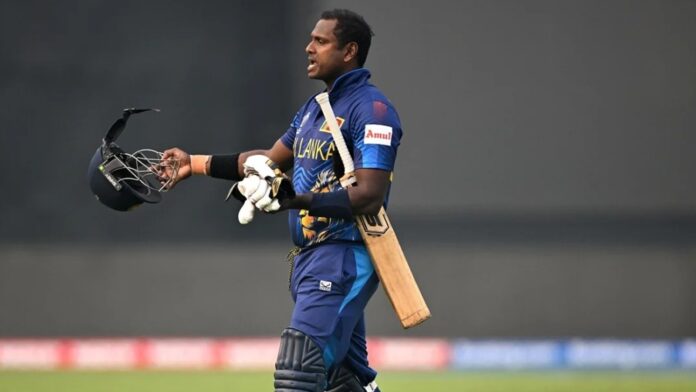The incident unfolded in the 25th over of the Sri Lankan innings when Bangladesh’s captain, Shakib Al Hasan, had just dismissed Sadeera Samarawickrama. Mathews, Sri Lanka’s former captain, walked to the crease but noticed that the strap of his helmet was broken. Without seeking permission from the umpires, he called for a new helmet. In response to this, the Bangladesh fielders decided to appeal for a time-out against Mathews.
After a prolonged discussion involving Mathews, the umpires (Richard Illingworth and Marais Erasmus), and Shakib, the decision was made to declare Mathews ‘timed out.’ Mathews, clearly frustrated, expressed his displeasure by tossing his helmet and equipment aside, becoming the first cricketer in international cricket to face a timed-out dismissal.
The controversy sparked a debate about the interpretation of the laws of the game. According to the laws, a batter must be ready to face the first ball within three minutes of the previous dismissal in international cricket. However, in World Cup matches, this time is reduced to two minutes. The playing conditions do not provide any leeway for equipment malfunctions as a reason for delaying play.
Some questions arise: Could Shakib have withdrawn the appeal? Should the umpires have considered Mathews’ broken helmet strap and used their discretion to give him the benefit of the doubt? To shed light on these matters, fourth umpire Adrian Holdstock provided clarification.
“ICC World Cup playing conditions supersede the MCC laws of cricket,” Holdstock explained. “The incoming batter has to be in position and ready to receive the ball within two minutes.” He emphasized that the two-minute limit had already been exceeded before Mathews experienced the helmet strap issue.
“ICC World Cup playing conditions supersede the MCC laws of cricket. When it comes to the timed out, at the fall of a wicket, or even retirement of a batter, the incoming batter has to be in position and ready to receive the ball within two minutes, or his other partner to receive the ball in two minutes,” explained Holdstock in an interview with former West Indies pacer Ian Bishop.
“We have certain protocols where the TV umpire, at the fall of the wicket, monitors the two minutes. And he will then relay the message to the on-field umpires. And in the instance this afternoon, the batter wasn’t ready to receive the ball within those two minutes, even before the strap became an issue for him,” said the fourth umpire.
‘I Am Never Going To Be As Good As Him’, Virat Kohli Outstanding Statement After Equalling Sachin’s 49th Hundred Record
“Yes, that’s correct, the two minutes had already elapsed before he had received the next delivery,” he added when Bishop asked him again about the timings.
“According to laws, the fielding captain initiated the appeal to Erasmus, who was the stand-in umpire, that he wanted to appeal for time out. Just after the strap came loose, the fielding captain appealed for time out.
“As a batter, you need to make sure you have all your equipment in place in order to make sure you get here. Actually, you have to be ready to receive the ball within two minutes – not get ready or prepare to take your guard. Technically, you should be there within 15 seconds to make sure all these things are in place before you actually receive the ball,” he added.
Mathews, however, disagreed with the decision. He took to social media to present his viewpoint, sharing video evidence that, according to him, indicated he still had five more seconds even after the helmet malfunctioned. Mathews emphasized the paramount importance of safety, stating that he couldn’t face a bowler without a helmet.
The Sri Lankan team promised to provide more ‘video evidence’ to support their claims. Mathews argued that the umpires could have at least reviewed the situation considering the safety aspect, highlighting the inconsistency in allowing a wicketkeeper to keep without a helmet. At the same time, he was expected to take his guard without one.
Proof! From the time catch was taken and the time helmet strap coming off pic.twitter.com/2I5ebIqkGZ
— Angelo Mathews (@Angelo69Mathews) November 6, 2023
“4th umpire is wrong here! Video evidence shows I still had 5 more seconds even after the helmet gave away! Can the 4th umpire rectify this, please? I mean, safety is paramount as I just couldn’t face the bowler without a helmet,” he wrote on X in reply to an ICC article about the reactions to the dismissal.
“Within two minutes, I was there. We have video evidence. We will put out a statement later on. We have video evidence footage, and everything was looked at. I’m not just coming and saying things here. I’m talking with proof.
“So, we have the video evidence where from the time the catch was taken, and then from the time I walked into the crease, I still had five seconds after breaking my helmet. So, we talk about the safety of the players – you guys tell me if It’s right for me to take my guard without my helmet on? It’s just pure common sense.
“That’s why I think the umpires also had a bigger job at the time because they could have at least gone back and checked. So, we talk about player safety. And a wicketkeeper for the spinner is not – they don’t let him keep without his helmet. So how can I take my guard without my helmet? It’s a complete equipment malfunction,” Mathews said.
As the debate rages on, it’s essential to remember that the incident was a significant point of contention in a World Cup match. Sri Lanka had posted a competitive total of 279, led by a century from Charith Asalanka. In response, Bangladesh, guided by Shakib’s brilliant knock of 82 and Najmul Shanto’s 90, managed to secure victory with three wickets in hand and 8.5 overs to spare.






















